2014 FIAT 500L LIVING rims
[x] Cancel search: rimsPage 2 of 420
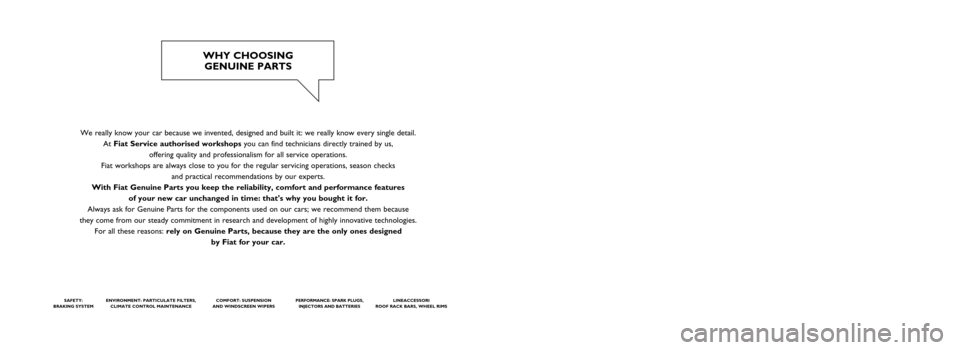
We really know your car because we invented, designed and built it: we really know every single detail.
At Fiat Service authorised workshopsyou can find technicians directly trained by us,
offering quality and professionalism for all service operations.
Fiat workshops are always close to you for the regular servicing operations, season checks
and practical recommendations by our experts.
With Fiat Genuine Parts you keep the reliability, comfort and performance features
of your new car unchanged in time: that's why you bought it for.
Always ask for Genuine Parts for the components used on our cars; we recommend them because
they come from our steady commitment in research and development of highly innovative technologies.
For all these reasons: rely on Genuine Parts, because they are the only ones designed
by Fiat for your car.
SAFETY:
BRAKING SYSTEMENVIRONMENT: PARTICULATE FILTERS,
CLIMATE CONTROL MAINTENANCECOMFORT: SUSPENSION
AND WINDSCREEN WIPERS PERFORMANCE: SPARK PLUGS,
INJECTORS AND BATTERIESLINEACCESSORI
ROOF RACK BARS, WHEEL RIMS
WHY CHOOSING
GENUINE PARTS
COP 500L UM GB SISTEMA 15-06-2012 8:30 Pagina 2
Page 165 of 420

AIRBAGThe car is equipped with front airbags for driver and
passenger, driver's knee bag (for versions/markets,
where provided), seat-mounted side airbags for
driver's and passenger pelvis-chest-shoulder
protection (for versions/markets, where provided),
and window airbags for protecting the heads of front
and rear outer occupants.
The location of the airbags on the car is marked by
the writing "AIRBAG" in the middle of the steering
wheel, on the dashboard, on the side trim or on
a label placed next to the airbag deployment area.
FRONT AIRBAGS
The front driver/passenger airbags and the driver's
knee bag (for versions/markets, where provided)
protect the front seat occupants in the event of
frontal impacts of medium/high severity, by placing
the bag between the occupant and the steering
wheel or dashboard.
Therefore non-deployment in other types of impacts
(side impacts, rear shunts, roll-overs, etc.) does not
indicate a system malfunction.
Front (driver and passenger) airbags are not a
replacement for, but are complementary to, the seat
belts, which you are recommended to always wear,
as specified by law in Europe and most non-European
countries.
In the event of impact, those not wearing a seat belt
are projected forwards and may come into contactwith the bag which is still inflating. The protection
offered by the bag is compromised in these
circumstances.
Front airbags may not activate in the following
situations:
❒frontal impacts against highly deformable objects
not involving the front surface of the car (e.g.
wing collision against guard rail, etc.);
❒underride impacts with other vehicles or wedging
under protective barriers (e.g. trucks or guard
rails).
Failure to activate in the conditions described above
is due to the fact that they may not provide any
additional protection compared with seat belts, so
their activation would be inappropriate.
In these cases, non-deployment of the airbag does
not necessarily indicate a system malfunction.
WARNING
Do not apply stickers or other objects
on the steering wheel, on the dashboard
in the passenger airbag area, on roof side trims
or on the seats. Never put objects (e.g. mobile
phones) on the passenger side of the dashboard
since they could interfere with correct inflation
of the passenger airbag and also cause serious
injur y to the passengers.
161GETTING TO KNOW
YOUR CARSAFETYSTARTING AND
DRIVING
WARNING LIGHTS
AND MESSAGES
IN AN EMERGENCY
SERVICING AND
MAINTENANCE
TECHNICAL
SPECIFICATIONS
INDEX
Page 168 of 420

SIDE AIRBAGS: SEAT-MOUNTED SIDE
AIRBAG (for versions/markets, where
provided) AND WINDOW AIRBAG
To help increase occupants protection in the event of
certain side impact collisions, the car is equipped
with seat-mounted side airbags (for versions/
markets, where provided) and window airbag.
Seat-mounted side airbag
(for versions/markets, where provided)
These comprise two types of bags located in the
front seat backrests fig. 147 which protect the pelvis,
chest and shoulder area of the occupants in the
event of a side impact of medium/high severity.
Window bag
This comprises a "curtain" bag located along both
sides of the roof rails above the front and rear doors
fig. 148 covered by special trims.
It is designed to protect the head of front and rear
occupants in the event of a side impact, thanks
to the wide cushion inflation surface.
The deployment of seat-mounted side airbags in the
event of side impacts of low severity is not required.
In the event of a side impact, the system provides
best protection if the passenger sits on the seat in a
correct position, thus allowing correct window
bag deployment.
IMPORTANT Do not affix rigid objects to the
garment hooks or support handles.IMPORTANT Do not rest your head, arms or elbows
on the door, windows or the area in which the
window bag is located to avoid possible injury during
airbag inflation.
fig. 147
F0Y0090
164GETTING TO KNOW
YOUR CAR
SAFETY
STARTING AND
DRIVING
WARNING LIGHTS
AND MESSAGES
IN AN EMERGENCY
SERVICING AND
MAINTENANCE
TECHNICAL
SPECIFICATIONS
INDEX
IMPORTANT Never lean your head, arms or elbows
out of the window.
Page 204 of 420
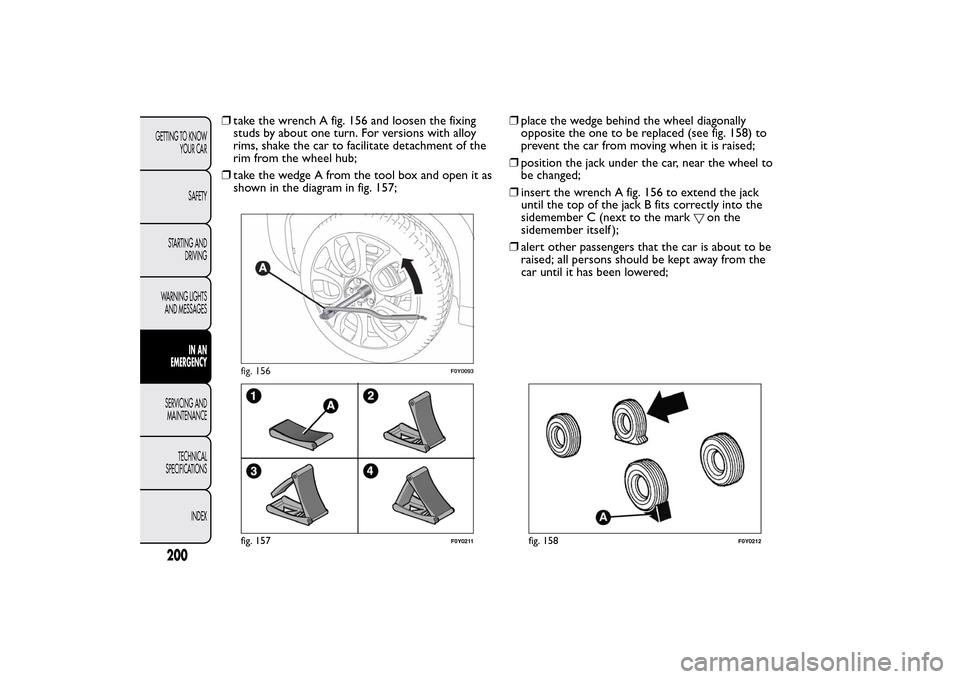
❒take the wrench A fig. 156 and loosen the fixing
studs by about one turn. For versions with alloy
rims, shake the car to facilitate detachment of the
rim from the wheel hub;
❒take the wedge A from the tool box and open it as
shown in the diagram in fig. 157;❒place the wedge behind the wheel diagonally
opposite the one to be replaced (see fig. 158) to
prevent the car from moving when it is raised;
❒position the jack under the car, near the wheel to
be changed;
❒insert the wrench A fig. 156 to extend the jack
until the top of the jack B fits correctly into the
sidemember C (next to the mark
on the
sidemember itself );
❒alert other passengers that the car is about to be
raised; all persons should be kept away from the
car until it has been lowered;
fig. 156
F0Y0093
fig. 157
F0Y0211
fig. 158
F0Y0212
200GETTING TO KNOW
YOUR CAR
SAFETY
STARTING AND
DRIVING
WARNING LIGHTS
AND MESSAGES
IN AN
EMERGENCY
SERVICING AND
MAINTENANCE
TECHNICAL
SPECIFICATIONS
INDEX
Page 206 of 420
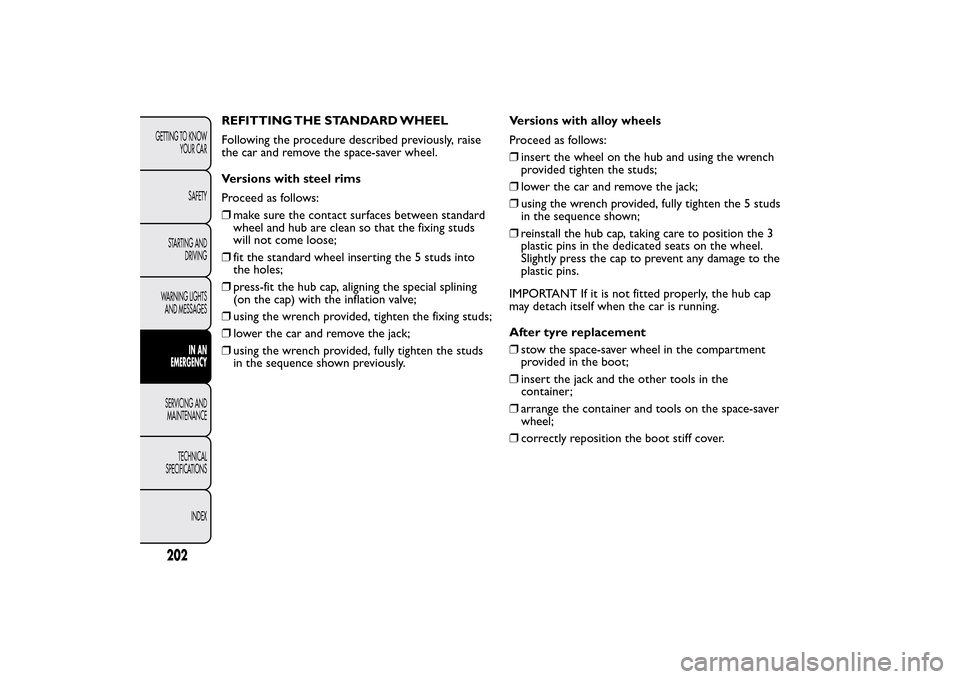
REFITTING THE STANDARD WHEEL
Following the procedure described previously, raise
the car and remove the space-saver wheel.
Versions with steel rims
Proceed as follows:
❒make sure the contact surfaces between standard
wheel and hub are clean so that the fixing studs
will not come loose;
❒fit the standard wheel inserting the 5 studs into
the holes;
❒press-fit the hub cap, aligning the special splining
(on the cap) with the inflation valve;
❒using the wrench provided, tighten the fixing studs;
❒lower the car and remove the jack;
❒using the wrench provided, fully tighten the studs
in the sequence shown previously.Versions with alloy wheels
Proceed as follows:
❒insert the wheel on the hub and using the wrench
provided tighten the studs;
❒lower the car and remove the jack;
❒using the wrench provided, fully tighten the 5 studs
in the sequence shown;
❒reinstall the hub cap, taking care to position the 3
plastic pins in the dedicated seats on the wheel.
Slightly press the cap to prevent any damage to the
plastic pins.
IMPORTANT If it is not fitted properly, the hub cap
may detach itself when the car is running.
After tyre replacement
❒stow the space-saver wheel in the compartment
provided in the boot;
❒insert the jack and the other tools in the
container;
❒arrange the container and tools on the space-saver
wheel;
❒correctly reposition the boot stiff cover.
202GETTING TO KNOW
YOUR CAR
SAFETY
STARTING AND
DRIVING
WARNING LIGHTS
AND MESSAGES
IN AN
EMERGENCY
SERVICING AND
MAINTENANCE
TECHNICAL
SPECIFICATIONS
INDEX
Page 260 of 420
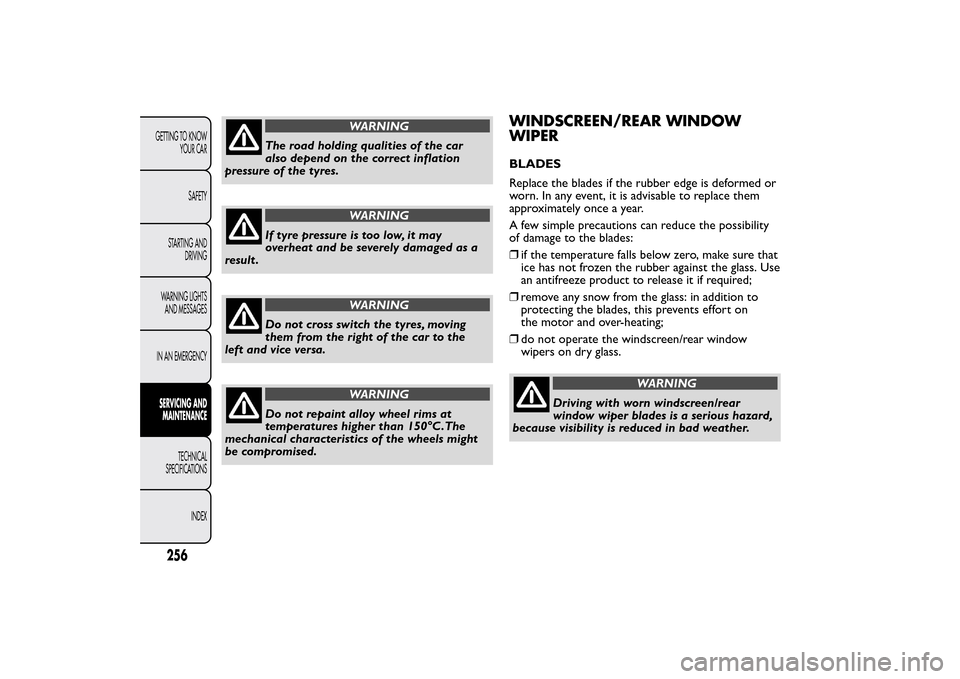
WARNING
The road holding qualities of the car
also depend on the correct inflation
pressure of the tyres.
WARNING
If tyre pressure is too low, it may
overheat and be severely damaged as a
result .
WARNING
Do not cross switch the tyres, moving
them from the right of the car to the
left and vice versa.
WARNING
Do not repaint alloy wheel rims at
temperatures higher than 150°C.The
mechanical characteristics of the wheels might
be compromised.
WINDSCREEN/REAR WINDOW
WIPERBLADES
Replace the blades if the rubber edge is deformed or
worn. In any event, it is advisable to replace them
approximately once a year.
A few simple precautions can reduce the possibility
of damage to the blades:
❒if the temperature falls below zero, make sure that
ice has not frozen the rubber against the glass. Use
an antifreeze product to release it if required;
❒remove any snow from the glass: in addition to
protecting the blades, this prevents effort on
the motor and over-heating;
❒do not operate the windscreen/rear window
wipers on dry glass.
WARNING
Driving with worn windscreen/rear
window wiper blades is a serious hazard,
because visibility is reduced in bad weather.
256GETTING TO KNOW
YOUR CAR
SAFETY
STARTING AND
DRIVING
WARNING LIGHTS
AND MESSAGES
IN AN EMERGENCYSERVICING AND
MAINTENANCE
TECHNICAL
SPECIFICATIONS
INDEX
Page 275 of 420
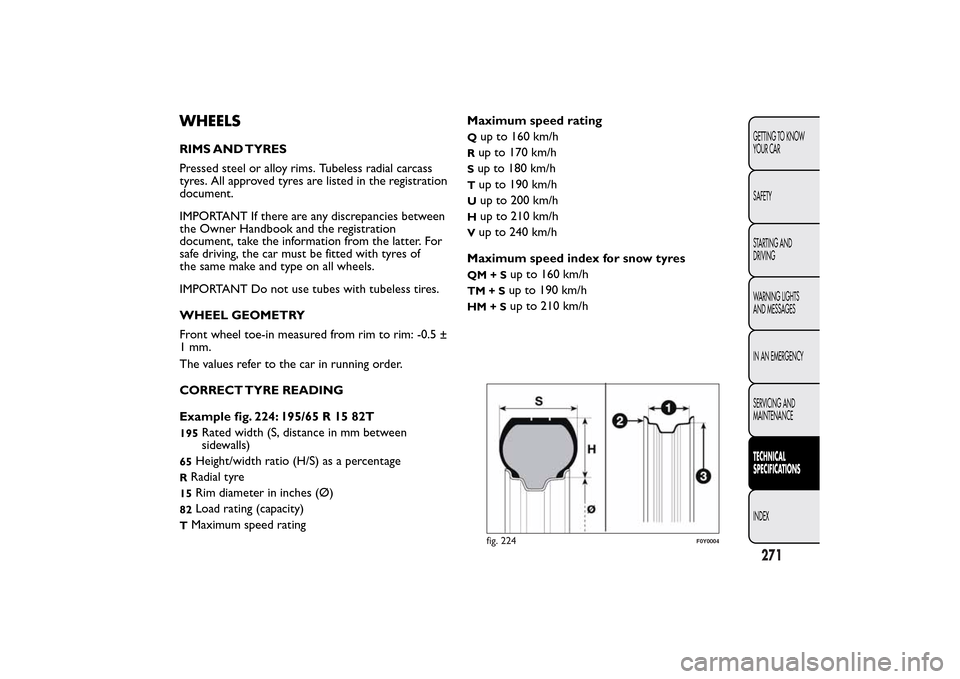
WHEELSRIMS AND TYRES
Pressed steel or alloy rims. Tubeless radial carcass
tyres. All approved tyres are listed in the registration
document.
IMPORTANT If there are any discrepancies between
the Owner Handbook and the registration
document, take the information from the latter. For
safe driving, the car must be fitted with tyres of
the same make and type on all wheels.
IMPORTANT Do not use tubes with tubeless tires.
WHEEL GEOMETRY
Front wheel toe-in measured from rim to rim: -0.5 ±
1 mm.
The values refer to the car in running order.
CORRECT TYRE READING
Example fig. 224: 195/65 R 15 82T195
Rated width (S, distance in mm between
sidewalls)
65
Height/width ratio (H/S) as a percentage
RRadial tyre15
Rim diameter in inches (Ø)
82
Load rating (capacity)
T
Maximum speed ratingMaximum speed rating
Q
up to 160 km/h
Rup to 170 km/hSup to 180 km/hT
up to 190 km/h
U
up to 200 km/h
H
up to 210 km/h
V
up to 240 km/h
Maximum speed index for snow tyres
QM+S
up to 160 km/h
TM+S
up to 190 km/h
HM+S
up to 210 km/h
fig. 224
F0Y0004
271GETTING TO KNOW
YOUR CAR
SAFETY
STARTING AND
DRIVING
WARNING LIGHTS
AND MESSAGES
IN AN EMERGENCY
SERVICING AND
MAINTENANCETECHNICAL
SPECIFICATIONSINDEX
Page 282 of 420
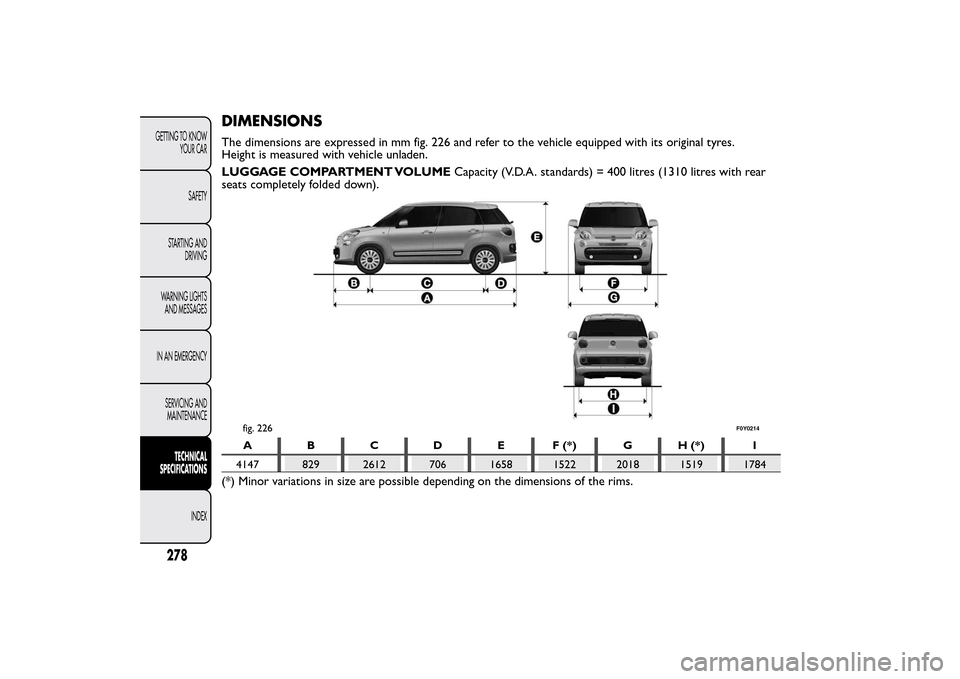
DIMENSIONSThe dimensions are expressed in mm fig. 226 and refer to the vehicle equipped with its original tyres.
Height is measured with vehicle unladen.
LUGGAGE COMPARTMENT VOLUMECapacity (V.D.A. standards) = 400 litres (1310 litres with rear
seats completely folded down).
A B C D E F (*) G H (*) I
4147 829 2612 706 1658 1522 2018 1519 1784
(*) Minor variations in size are possible depending on the dimensions of the rims.
fig. 226
F0Y0214
278GETTING TO KNOW
YOUR CAR
SAFETY
STARTING AND
DRIVING
WARNING LIGHTS
AND MESSAGES
IN AN EMERGENCY
SERVICING AND
MAINTENANCE
TECHNICAL
SPECIFICATIONS
INDEX